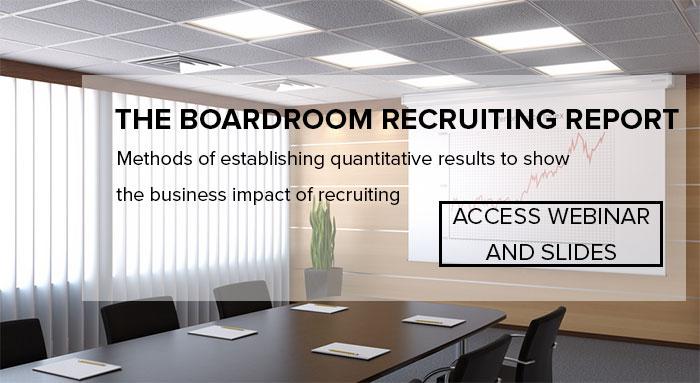 Organizations understand the importance of talent acquisition. Their assumptions about it's importance, albeit accurate assumptions, reflect the need to act on these beliefs but not necessarily how to act on these beliefs. Great talent is key to a company's competitive advantage, and is central to achieving business goals, but the hard part is understanding these assumptions enough to make the right decisions regarding talent acquisition. Here's how to understand these assumptions in a way that illustrate the business impact of recruiting, and how to get the resources you need to acquire the best talent:
Organizations understand the importance of talent acquisition. Their assumptions about it's importance, albeit accurate assumptions, reflect the need to act on these beliefs but not necessarily how to act on these beliefs. Great talent is key to a company's competitive advantage, and is central to achieving business goals, but the hard part is understanding these assumptions enough to make the right decisions regarding talent acquisition. Here's how to understand these assumptions in a way that illustrate the business impact of recruiting, and how to get the resources you need to acquire the best talent:
Speak the Language of Your Business
"In recruiting, money is muscle. The more money you have to put into it, the better the results should be," said Mike Mayeux, CEO of Novotus. "There's too much attention paid to the cost of recruiting and [there's no] passion to invest in recruiting to get the outcomes that they would need."
To get that money, you need to speak the language of your business, or know the goals the senior leadership wants to achieve and align recruiting with those goals. For example, if your organization has several positions open in sales, then it's best the communicate the need to fill those positions in terms of the revenue lost. This aligns with leadership's goal of increased sales and revenue, while showcasing your need for additional resources to fill these positions. To get these numbers, make sure to partner with finance to develop that hard data and to drive business results.
Know the Impact of Turnover and Speed of Hire
Cost of turnover is often underestimated. According to Staffing.org 2010 Corporate Recruiting report, here are the actual average turnover costs for non-exempt workers, middle managers, and upper-level managers:
- Non-Exempt Workers - 50% of base salary
- Middle Managers - 100 to 150% of base salary
- Upper-Level Managers - 200 to 250% of base salary
With these numbers of mind, the profitability impact of the speed to hire metric has a whole new meaning for the business. Not only does the turnover itself cost money, but revenue is lost  with each day that position is left unfilled. As you can see in the graphic to the left, that lost revenue can be in the millions if you leave these positions unfilled for over 30 days. On top of that, consider the profits that are lost with this revenue. If your organization lost $15.3 million each year because of unfilled positions, and the company is operating at a 10% profit margin, then that's a little over $1.5 million in profits lost because of unfilled positions. Therefore, speed of hire should be consider in conjunction of turnover rate, as those costs compound.
with each day that position is left unfilled. As you can see in the graphic to the left, that lost revenue can be in the millions if you leave these positions unfilled for over 30 days. On top of that, consider the profits that are lost with this revenue. If your organization lost $15.3 million each year because of unfilled positions, and the company is operating at a 10% profit margin, then that's a little over $1.5 million in profits lost because of unfilled positions. Therefore, speed of hire should be consider in conjunction of turnover rate, as those costs compound.
Don't Forget Candidate Quality
The ability to source high quality candidates quickly can have a high impact on business profitability and revenue. If you can do this well, then you can reduce poor performance while increasing organizational value. It also gives you a chance to measure quality of hire, which can be done by looking at the attrition umbers. The faster you can source high quality candidates, then the more you can reduce lost revenue and lost productivity, as we discussed in the previous section.
"You want it good... and you want it fast," Mayeux said. "But, you got to be willing to pay for those two things. Those are the two big ROI areas... and [being cheap] no longer becomes a really huge problem"
According to a recent study (August 2012), the Boston Consulting Group found that out of all HR functions, recruiting has the highest impact on revenue growth and profit margins. In this hour-long webinar, explore the hidden earning potential of recruiting by learning:
- Methods of establishing quantitative results to show the business impact of recruiting
- Examples of the potential cost savings associated with recruiting
- Metrics to link lost revenue associated with recruiting and speed of hire
- A method to measure the revenue impact associated with quality of hire
If human resources are managed well, then they can turn into an asset instead of a cost. View the slides and webinar here today.














